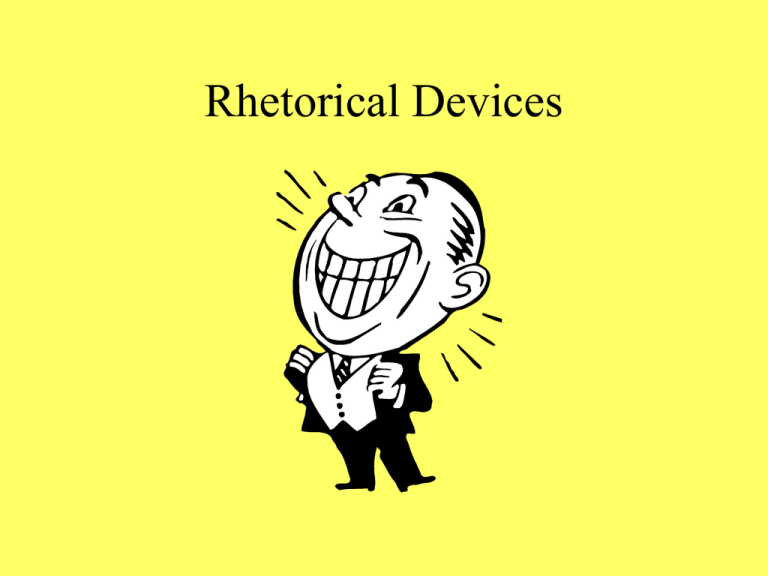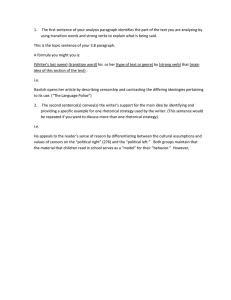Rhetorical Devices
advertisement

Rhetorical Devices Tropes • A rhetorical device in which MEANING is altered from the usual or expected. Schemes • A rhetorical device in which WORD ORDER is altered from the usual or expected. Kinds of Tropes Metaphor • An implied comparison between two unlike things • Example: “True art is a conduit between body and , soul, between feeling unabstracted and abstraction unfelt.” John Gardner, On Moral Fiction Simile • An explicit comparison between two unlike things signaled by the use of “like” or “as.” • Example: “Laws are like cobwebs, which may catch small flies, but let wasps and hornets break through.” Jonathan Swift, “A Critical Essay Upon Faculties of the Mind” Synecdoche • A whole is represented by naming some of its parts. • Translated from Greek, means “understanding one thing for another.” • Example: “Nice wheels” Metonymy • Reference to something or someone by naming one of its attributes. • Example: The head of the council is called the “chair.” Personification • Attributing human qualities to an inanimate object. • Example: The clock cast a watchful eye over the class as they wrote their essay. Puns (3 types) • Repetition of a single word in two different senses. • Example: “But if we don’t hang together, we will hang separately.” Benjamin Franklin Puns cont. • A play on words that sound alike but are different in meaning. • Example: He couldn’t get his bearings straight in the Bering Strait. Puns cont. • Antanaclasis: Use of a single word with two different meanings within the context of the sentence. • Example: The ink, like our pig, keeps running out of the pen. Onomatopoeia • The use of words whose sound reinforces their meanings. • Examples: drip, crackle, ban, snarl, pop Euphemism • Substituting less pungent words for harsh ones, with excellent ironic effect. • Example: The schoolmaster corrected the slightest fault with his birch reminder. Hyperbole • Deliberate exaggeration for emphasis. • Example: “Four hostile newspapers are more to be feared than a thousand bayonets.” Attributed to Napoleon Bonaparte Litotes • A deliberate understatement • Intensifies an idea by understatement • Example: “It wasn’t my best moment.” Rhetorical Question—Type 1 • Asking the reader • Greeks viewed this as a way of taking counsel with the reader. • Example: “What would you have done in these circumstances?” Rhetorical Question—Type 2 • Asking the writer • Suggests the writer’s thinking process • Example: “What was it I really wanted?” Rhetorical Question—Type 3 • Criticizing—makes a criticism in the form of a question • Example: “How can citizens fail to vote?” Rhetorical Question—Type 4 • Asking and answering • Sometimes serves as a way to organize a writer’s arguments Irony • Means “liar” or “dissembler” • Allows the writer to take another voice or role that states the opposite of what is expressed. “The new swimming pool was an important addition to the campus, even though library funds had to be cut back. After all, we wouldn’t want our students to go without the little luxuries they are accustomed to.” Oxymoron • Two contradictory terms used together • “Parting is such sweet sorrow.” Paradox • A statement that appears to be contradictory, but, in fact, has some truth. • Example: “He worked hard at being lazy.” Apostrophe • “Turning away” from the audience to address someone new—God, heaven, angels, the dead…anyone not present. • Example: “Death, where is thy sting?” Schemes Parallelism • Expresses similar or related ideas in similar grammatical structures. • Example: “Hell is gaping for them, the Devil is waiting for them…” Climax • Writer arranges ideas in order of importance • Example: I spent the day cleaning the house, reading poetry, and putting my life in order. Antithesis • The juxtaposition of contrasting ideas • Example: ‘Our knowledge separates as well as unites; our orders disintegrate as well as bind…” Anaphora • Repetition of the same word or phrase at the beginning of successive phrases or clauses. • Example: “We shall fight on the beaches, we shall fight on the landing grounds…” Epistrophe • Repetition of the same word or group of words a the ends of successive clauses. • Example: Shylock: I’ll have my bond! Speak not against my bond! I have sworn an oath that I will have my bond! Epanalepsis • Repeating at the end of a clause the word that occurred at the beginning. • Example: “Blood hath brought blood, and blows answer’d blows…” King John Alliteration • Repetition of the same sound at the beginning of successive words. • Example: “We shall not flag or fail.” Assonance • Repetition of sounds within words • Example: “The heave’e’yo of stevedores…” Anastrophe • Word order is reversed or rearranged. • In Greek it means “turning back” • Example: “Unseen in the jungle, but present, are tapirs, jaguars, many species of snake…” Parenthesis • The insertion of words, phrases, or a sentence that is not syntactically related to the rest of the sentence. • Set off by dashed or parentheses • Example: “He said it would rain—I could hardly disagree—before the game was over.” Apposition • The placing next to a noun another noun or phrase that explains it. • Example: “Pollution, the city’s biggest problem, is an issue.” Asyndenton • Conjunctions are omitted, producing a fastpaced and rapid prose. • Example: “I came, I saw, I conquered.” Polysyndenton • The use of many conjunctions has an opposite effect—slowing the pace. • Example: “I kept remembering everything—the small steamboat that we rode on, and how quietly she ran on the moonlight sails, and how sweet the music was on the water, and what it felt like to think about girls then.”



